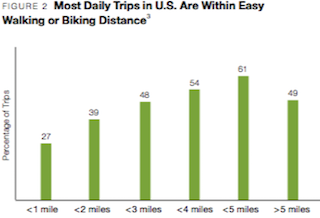Lack of physical activity is estimated to be now costing the US health budget $117 billion dollars a year, or about 10 per cent of health care costs.
According to the latest US household travel survey data, only 11 per cent of all trips are taken by foot, one per cent by bicycle, and two per cent by public transport (which usually also involves either walking or riding a bicycle to and from a train station or a bus stop).
The results are published in the latest review by Active Living Research—Moving Toward Active Transportation: How Policies Can Encourage Walking and Bicycling.
The report says active travel can be a big help in reaching recommended daily levels of physical activity of at least 30 minutes on most days, or 150 minutes per week.

“Driving is a major source of physical inactivity and is associated with overweight and obesity . . . evidence suggests that higher levels of driving (either as time or distance in a motor vehicle) are associated with a higher risk of increased weight.
“One reason why so many people drive in the US is decades of car-centric planning, which has led to a system that makes driving convenient and cheap, but poses many obstacles to walking, cycling, and transit use. Examples of car-centric planning include:
- Transportation decisions have mostly been based on measurements of the delays that cars experience on existing roads, a practice that can lead to the building of large roads that only accommodate cars.
- A minimum supply of car parking mandated for most new buildings, such as private homes, businesses, shops, or restaurants. As a result, for most trips in the US, car parking is free, and there is often an ample supply of it.
- The federal government allows a deduction of up to $250 for car parking, compared to a $130 deduction for purchasing transit/commuter tickets.
- Gasoline and vehicle taxes pay only about 60–70 per cent of roadway building and maintenance expenditures by all levels of government. The rest is paid for by non-transport related taxes, such as property, sales, or income taxes.
The review says that provision of convenient, safe, and connected walking and cycling infrastructure is at the core of promoting active travel.
“Physically separating cyclists and pedestrians from cars, where motorized traffic volumes and speeds are high, is important. So is reducing vehicle speeds and traffic volume through traffic calming on other streets.”
The study reports that people who cycle or walk for any purpose at a level that meets recommendations for physical activity (ie 150 minutes/week), the risk of mortality for all causes is reduced by about 10 per cent.
And the risk of cardiovascular diseases is reduced by 16 per cent for people who walk three hours per week and by 11 per cent for people who actively commute (compared to people who do not actively commute).
Re-blogged from Bicycle Network Health Policy and Studies
Ride On content is editorially independent, but is supported financially by members of Bicycle Network. If you enjoy our articles and want to support the future publication of high-quality content, please consider helping out by becoming a member.

